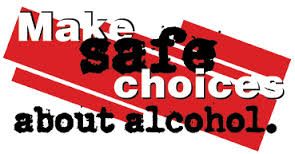Alcohol Awareness
Alcohol Awareness
Facts about Alcohol
- Alcohol is a depressant drug that slows the central nervous system which can cause drowsiness, sleep or pain relief.
- A 355 ml (12 oz) beer at 5% contains the same amount of alcohol as 150 ml (5 oz) glass of wine at 12% and 40 ml (1.5 oz) of spirits at 40%.
- Did you know? Men and women absorb alcohol differently. Women have less fluid in their bodies to dilute alcohol, and less of an enzyme that breaks down alcohol. So women feel more of the effects, and for a longer time, than men who drink the same amount.
- Coffee will not sober you up; only time can make you sober.
- It is illegal for someone under 19 years of age to drink, possess, purchase or otherwise obtain alcohol.
You and safer drinking
When you enjoy alcohol, it can be easy to get into a routine of drinking too much, too often or in risky environments. Here are some simple things you can do to reduce your risk of harm from alcohol.
Before you start...
- Be clear about why you want to drink. Is it going to help you in some way or make things worse?
- Eat something. Food reduces the speed at which your body absorbs alcohol.
- Know the strength of your alcohol. Look on the label for the percentage of alcohol.
- Set limits on how much you’re going to drink and, commit to sticking to your plan.
While drinking...
- Measure and keep track of your drinks. This will help you avoid drinking more than you wanted.
- Drink slowly. Alternate drinks with water or other non-alcoholic beverages to avoid drinking too much.
- Stay in the company of trusted friends.That way, you won’t have to cope alone if something goes wrong.
When going out...
- Choose drinking places with care. Look for clean surroundings, good lighting, open queuing, comfortable seating, pleasant noise levels and lots of space. Things can get out of control in places that are too crowded and chaotic.
- Plan a safe way to get home before you even get to your destination. You’ll be less tempted to make bad choices if you have a good plan.
- Avoid getting drunk in public.
- Stay within the national low-risk alcohol drinking guidelines of 4 drinks for men, 3 drinks for women, on any one occasion. Drinking over these limits puts you at risk of making bad choices that may seem fun or funny at the time but may cost you later in terms of your health, relationships, money or the law.
If you’re planning to drink a lot...
- Drink with a buddy in a safe place. It may be best to stay at home.
- Stick to one substance at a time. Alcohol can magnify the effects of cannabis and some other drugs in unpredictable ways.
- Stay away from the steering wheel.
- Stay where you are or make plans to get around by bus, taxi, or ride with someone who hasn’t been drinking.
- Avoid having sex with an unfamiliar partner. Carry condoms just in case.
Choose “no alcohol” when...
- Driving or operating machinery
- Needing to be alert, like at work or school
- Using other drugs, including medications
- Pregnant or breastfeeding
- Experiencing health problems (mental or physical)
To reduce long-term health risks...
- Avoid daily or almost-daily drinking
- Keep one or two days per week alcohol-free, and have no more than 15 drinks per week if you’re a man, 10 per week if you’re a woman.
Things to avoid...
- Drinking regularly (and especially getting drunk) before early adulthood
- Drinking regularly to cope with negative moods or as a major form of recreation
- Driving after drinking, or riding in a vehicle with someone who’s been drinking
- Trying to keep up with your friends who drink more or more often than you do.
- Playing drinking games that encourage rapid ingestion of alcohol.
If someone passes out or ODs on alcohol...
- Roll the person on their side (so they won’t choke if they throw up)
- Call out for help—stay with the person who’s in trouble
- Call (or get someone else to call) 911
- Tell paramedics as much as you can
Getting Help IF you Are Worried About Your Drinking or Drinking of a Friend
Self-help tools:
- www.heretohelp.bc.ca
- www.carbc.ca
- Alcohol and Drug Information and Referral Service: 1-800-663-1441 (BC)
http://www.heretohelp.bc.ca/factsheet/safer-drinking-beer-wine-and-spirits
Dangers of Intoxication
- Excessive doses of alcohol can result in respiratory depression and death. It is even more dangerous to combine alcohol with other drugs. A small amount of alcohol can unsafely interact with drugs such as cold medications, antidepressants, or antihistamines and when moderate amounts of alcohol are combined with other depressant drugs such as sleeping pills or tranquilizers, death can occur.
- Driving under the influence of alcohol is a serious issue for those who drink and drive and other motorists on the road. In Canada, a blood alcohol content of 0.08% is the measure of legal impairment.
- Drinking during pregnancy increases the risk of Foetal Alcohol Spectrum Disorder (FASD). Research shows that there is a strong correlation between violence and alcohol abuse.
- Remember one standard drink is:
- Beer 350 ml (12 oz) at 5% alcohol
- Wine 150 ml (5 oz) at 12% alcohol
- Spirits 40 ml (1.5 oz) at 40% alcohol

